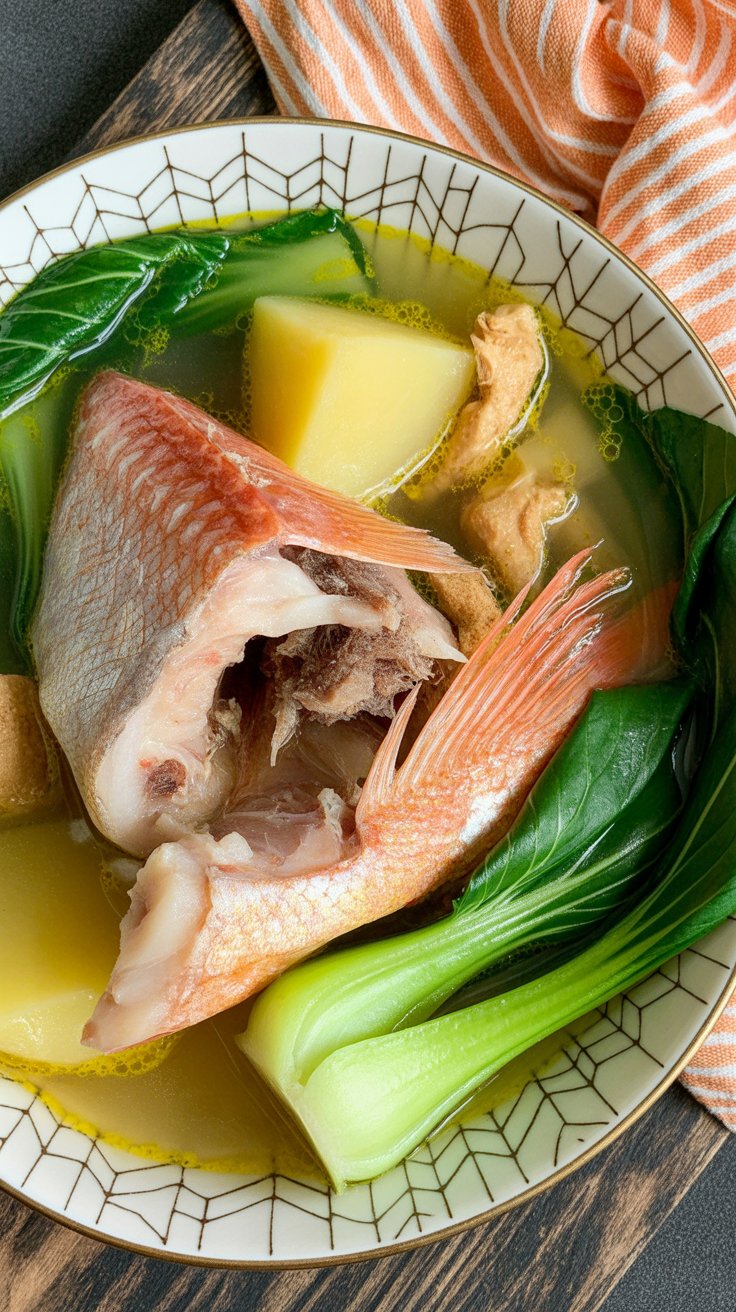There are some dishes that feel like a warm blanket, and this fish and ginger broth has always been one of them for me. On rainy days, especially the kind when the sky stays gray for hours, a pot of this simmering on the stove makes the whole house feel calm. The broth is light but full of flavor, the fish stays tender, and the vegetables soak up just the right amount of warmth from the ginger.

I’ve made this for quick weekday lunches, slow weekend dinners, and those moments when I want something soothing without being heavy. It uses simple ingredients, nothing fancy, but the comfort it brings is something I rely on. Every spoonful feels familiar in the best way.
Why This Dish Finds a Place in My Weekly Cooking
What I love most about this broth is how gentle it tastes while still being satisfying. The ginger warms the broth, the potatoes add body, and the cabbage softens just enough to make every spoonful cozy. The fish cooks quickly and absorbs the broth beautifully, making the whole dish feel balanced and homestyle.
It’s a great recipe for days when meals need to stay simple and budget-friendly. Everything cooks in one pot, and cleanup is just as easy. Even on busy days, it’s a dish I can make without feeling rushed.
Ingredients That Bring This Broth Together
Here’s how each part of the dish adds character to the final bowl:
-
Red snapper or similar fish gives the broth a clean, mild flavor.
-
Ginger, onion, and garlic form the base of the broth and bring that warm aroma that makes the dish so comforting.
-
Fish sauce, pepper, and a little salt give the broth depth without overshadowing the fish.
-
Potatoes and cabbage add body and sweetness.
-
Bok choy softens gently and gives the broth more freshness.
-
Water or rice wash keeps the broth clear while adding a subtle richness.
-
A little oil helps sear the fish before simmering.
These ingredients work together quietly, creating a broth that feels more nourishing with every bite.

How I Cook Pesang Isda at Home
I start by sautéing the aromatics. Ginger, onion, and garlic go into the pot, and I wait for the ginger to release its scent—it’s always the first sign that the broth will turn out well.
I fry the fish lightly before boiling. This step keeps the pieces firm and adds a gentle richness to the broth. Once the aromatics soften, I add water, season it, bring it to a simmer, and add the potatoes. When they’re almost tender, the fish goes in to cook gently. The cabbage and bok choy go in last so they stay soft but not mushy.
By the time it’s done, the broth looks clear but tastes bold, with the ginger leading the way.
Cooking Notes I’ve Learned Over Time
These small details always help me get the best results:
-
Frying the fish first keeps the pieces intact and gives the broth more flavor.
-
Cutting the potatoes evenly helps them cook at the same pace.
-
Adding leafy vegetables last keeps them from turning too soft.
-
Washing bok choy well avoids grit in the broth.
-
Using rice wash adds a gentle richness to the soup.
These small habits make the dish feel more balanced and steady.
Serving Suggestions and Storage
This dish is always best served hot, with a generous mound of rice. I usually set out a tiny dish of fish sauce for dipping, and it brings the flavors together perfectly. Some days I add a small bowl of miso dip on the side for a deeper, bolder taste.
Leftovers keep well for up to three days in the fridge. When reheating, I use a pot on the stove so the fish doesn’t break apart.

FAQs
What kind of fish works best?
Any firm, meaty fish works well—snapper, tilapia, catfish, or grouper all cook beautifully in this broth.
Do I have to fry the fish first?
You don’t have to, but frying keeps the pieces intact and gives the broth more depth.
Can I add other vegetables?
Yes. Chayote, string beans, or Napa cabbage work nicely and still keep the dish traditional.
Can I use broth instead of water?
Yes, but the dish stays closer to its roots when the broth is flavored mostly by the ginger and fish.
Can I make this ahead?
Yes, though the vegetables soften slightly when reheated. The flavors deepen, which I personally enjoy.
Pesang Isda Recipe (Fish in Ginger Broth)

Pesang Isda is one of those comforting Filipino dishes that warms you from the inside out.
Ingredients
- 1 kg red snapper, about 3 pieces, halved
- 2 cloves garlic, minced
- 1 small onion, sliced
- 2 thumbs ginger, julienned
- 2 medium potatoes, peeled and quartered
- 2–3 bunches bok choy, leaves separated
- 1 small cabbage, quartered
- 2 ½ tablespoons fish sauce
- 5 cups water
- ½ teaspoon ground pepper
- Salt, to taste
- Oil for frying
Instructions
- Season the fish generously with salt, making sure to coat all sides.
- Heat oil in a frying pan and cook the fish until the exterior turns golden. Set the pieces aside while you prepare the broth.
- In a clean pot, sauté the garlic, onion, and ginger until fragrant. Pour in the fish sauce and water, stirring gently to bring the flavors together.
- Add the potatoes, cover the pot, and let them cook until they turn tender.
- Stir in the ground pepper, then carefully place the fried fish and cabbage into the broth. Cover and simmer for a couple of minutes so the flavors meld.
- Add the bok choy, cover again, and cook just until the greens soften.
- Transfer the soup to a serving bowl and enjoy hot with freshly steamed white rice.
Nutrition Information
Yield
6Serving Size
1Amount Per Serving Calories 298Total Fat 4gSaturated Fat 1gUnsaturated Fat 3gCholesterol 79mgSodium 304mgCarbohydrates 18gFiber 3gSugar 4gProtein 47g
Easy Shrimp Recipes.com, occasionally offers nutritional information for recipes contained on this site. This information is provided as a courtesy and is an estimate only. This information comes from online calculators. Although allchickenrecipes.com attempts to provide accurate nutritional information, these figures are only estimates.
Final Thought
This ginger fish broth has a way of bringing warmth to days that feel a little heavy. It’s simple, filling, and made with ingredients most of us already keep on hand. Whether you’re cooking for family or just feeding yourself, a bowl of this on a quiet evening can feel like the exact thing you needed. It’s one of those dishes that reminds you how comforting a simple meal can be.

